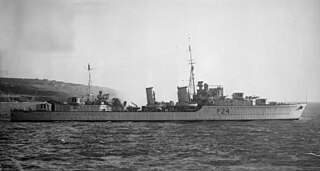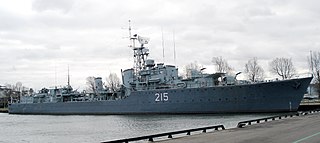Māori or Maori can refer to:
Māori or Maori can refer to:

The Cook Islands is an island country in Polynesia, part of Oceania in the South Pacific Ocean. It consists of 15 islands whose total land area is approximately 236.7 square kilometres (91 sq mi). The Cook Islands' Exclusive Economic Zone (EEZ) covers 1,960,027 square kilometres (756,771 sq mi) of ocean. Avarua is its capital.
Nine ships of the Royal Navy have been named HMS Glasgow after the Scottish city of Glasgow:

HMS Maori was a Tribal-class destroyer named after the indigenous Māori people of New Zealand. She served with the United Kingdom Mediterranean Fleet during World War II until she was bombed and sunk by German aircraft while at Malta in 1942. Her wreck was later raised and scuttled outside the Grand Harbour. The wreck is now a dive site.
Three ships of the Royal Navy have been named HMS Gurkha, while two have been named HMS Ghurka, after a people who originate in Nepal and who serve with distinction in the British Army as part of the Brigade of Gurkhas.
Thirteen vessels of the Royal Navy have borne the name HMS Mohawk, after the Mohawk, an indigenous tribe of North America:

The Tribal class, or Afridi class, was a class of destroyers built for the Royal Navy, Royal Canadian Navy and Royal Australian Navy that saw service in World War II. Originally conceived during design studies for a light fleet cruiser, the Tribals evolved into fast, powerful destroyers, with greater emphasis on guns over torpedoes than previous destroyers, in response to new designs by Japan, Italy, and Germany. The Tribals were well admired by their crews and the public when they were in service due to their power, often becoming symbols of prestige while in service.

The first HMS Zulu was a Tribal class destroyer launched 16 September 1909 at Hawthorn Leslie Shipyard and commissioned in March 1910. She was mined during the First World War, on 27 October 1916 off Dover in a minefield lain by the Imperial German submarine UC-1. Her stern was blown off and sank, but the forward section remained afloat. It was towed into port and attached to the stern of Nubian, which had been torpedoed, to form a new destroyer named HMS Zubian.
Six ships of the Royal Navy have borne the name HMS Cossack, after the Cossack people of Eastern Europe, whilst another was begun but was cancelled while building:
There have been two Royal Navy ships called HMS Maori after the indigenous people of New Zealand:
Three ships of the Royal Navy have been named HMS Nubian after the people of Nubia.

HMS Ashanti was a Tribal-class destroyer of the Royal Navy. Following the style of her sister ships she was named for an ethnic group, in this case the Ashanti people of the Gold Coast in West Africa. She served in the Second World War and was broken up in 1949. She was the first of two Royal Navy ships to bear the name Ashanti.

HMS Ghurka was a Tribal-class destroyer built in 1907 for the Royal Navy. She served as part of the Dover Patrol during the First World War, playing a part in the sinking of the German submarine U-8 in 1915, and was sunk by a German mine in 1917.
Two ships of the Royal Navy have been named HMS Viking, after the Vikings, whilst another Viking was in service with the Royal New Zealand Navy:

HMS Maori was one of five ships of the third batch of Tribal-class destroyers built for the Royal Navy in the first decade of the twentieth century. Completed in 1909, she spent her career in British waters. During the First World War, she served in the North Sea and the English Channel with the 6th Destroyer Flotilla. She struck a mine in the North Sea on 7 May 1915 off Zeebrugge, Belgium, and sank.
Several ships of the British Royal Navy have been named HMS Partridge, after the bird.
Three ships of the Royal Navy have borne the name HMS Crusader, after the participants in the Medieval Crusades:
The following index is provided as an overview of and topical guide to Wikipedia's articles on recreational dive sites. The level of coverage may vary:
Matenga is often a Māori name. Notable people with the name include:

Recreational dive sites are specific places that recreational scuba divers go to enjoy the underwater environment or for training purposes. They include technical diving sites beyond the range generally accepted for recreational diving. In this context all diving done for recreational purposes is included. Professional diving tends to be done where the job is, and with the exception of diver training and leading groups of recreational divers, does not generally occur at specific sites chosen for their easy access, pleasant conditions or interesting features.